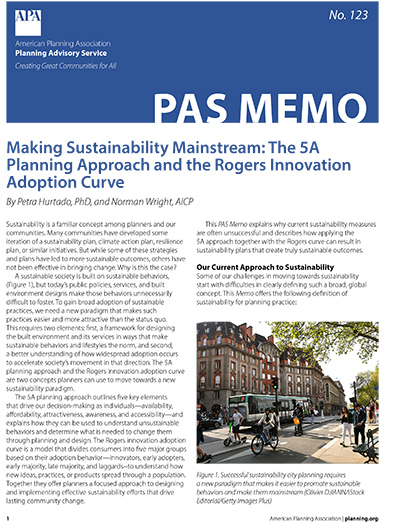Making Sustainability Mainstream: The 5A Planning Approach and the Rogers Innovation Adoption Curve
PAS Memo 123
By Petra Hurtado, PhD, Norman Wright, AICP

Many communities have developed some iteration of a sustainability plan, climate action plan, resilience plan, or similar initiatives. But while some of these strategies and plans have led to more sustainable outcomes, others have not effectively brought change. Why is this the case?
A sustainable society is built on sustainable behaviors, but today's public policies, services, and built environment designs make those behaviors unnecessarily difficult to foster. To gain broad adoption of sustainable practices, we need a new paradigm that makes such practices easier and more attractive than the status quo. The 5A planning approach and the Rogers innovation adoption curve are two concepts planners can use to move towards a new sustainability paradigm.
The 5A planning approach outlines five key elements that drive our decision-making as individuals — availability, affordability, attractiveness, awareness, and accessibility — and explains how they can be used to understand unsustainable behaviors and determine what is needed to change them through planning and design. The Rogers innovation adoption curve is a model that divides consumers into five major groups based on their adoption behavior — innovators, early adopters, early majority, late majority, and laggards — to understand how new ideas, practices, or products spread through a population. Together, these concepts offer planners a focused approach to designing and implementing effective sustainability efforts that drive lasting community change.
This PAS Memo explains why current sustainability measures are often unsuccessful and describes how applying the 5A approach together with the Rogers curve can result in sustainability plans that create truly sustainable outcomes.
Details
About the Authors
Petra Hurtado, PhD
Petra (Stieninger) Hurtado, Ph.D. is the Chief Foresight & Knowledge Officer at the American Planning Association, leading APA’s foresight practice to leverage knowledge as a catalyst for innovation and resilience in the planning profession and the organization.
She has a Ph.D. in urban planning from the Vienna University of Technology. Her areas of expertise and research include strategic foresight, futures literacy, urban futures and emerging technologies, urban sustainability, and environmental psychology.
Before joining APA, Petra worked as an advisor, planner, and educator in the global sustainability arena. As an adjunct professor, Petra has taught courses on planning with foresight at the University of Maryland and on urban sustainability and environmental psychology at the Vienna University of Technology. She has presented as a keynote speaker and subject matter expert at numerous conferences across the globe and guest lectured at Harvard GSD, Virginia Tech, among other universities.
Passionate about empowering people to thrive in dynamic environments, Petra combines academic rigor with practical wisdom to inspire action and drive positive change.
Norman Wright, AICP
Norman Wright, AICP, is the founder of Parameter, a design and analytics consultancy that specializes in creating plans, policies, and best practices for local government. Prior to this, he was a local government executive leading planning, economic development, and community development efforts in Oregon, Colorado, Tennessee, and South Carolina. His teams have delivered award-winning work recognized by the American Planning Association and Urban Land Institute. He holds a master’s degree in city and regional planning from Clemson University.


